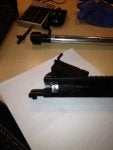A while back, I picked up my first bolt action rifle, an ASG AW.308. Great bang for the buck! (for someone trying out the airsoft or bolt action side of life!)
As with any similar level rifle, they will eventually wear down and require some love...or a new level up rifle.
Well, I did both, but the funny thing was, I kept going back to my AW.308, and so began the adventure!
Along the way, I determined that I needed a 90 deg trigger sear (among many other things). So I came up with my own design, and figured that I would do a log of building my own stainless steel sears to convert my stock trigger assembly to a 90 deg trigger, that can hold great loads.
While documenting the process, I then realized that it was more of a journal of my whole adventure with my AW.308.
Please do note that I do not feel that everything here is absolute! We are always learning, and we all have learnt from our own mistakes. To continue forward, we have to. I am always trying new and different things, and testing theories, even if they conflict with my own!
**THIS IS A WORK IN PROGRESS**
**AS I COMPLETE DOCUMENTING SECTIONS, I WILL ADD THEM**
So without further adieu....
As with any similar level rifle, they will eventually wear down and require some love...or a new level up rifle.
Well, I did both, but the funny thing was, I kept going back to my AW.308, and so began the adventure!
Along the way, I determined that I needed a 90 deg trigger sear (among many other things). So I came up with my own design, and figured that I would do a log of building my own stainless steel sears to convert my stock trigger assembly to a 90 deg trigger, that can hold great loads.
While documenting the process, I then realized that it was more of a journal of my whole adventure with my AW.308.
Please do note that I do not feel that everything here is absolute! We are always learning, and we all have learnt from our own mistakes. To continue forward, we have to. I am always trying new and different things, and testing theories, even if they conflict with my own!
**THIS IS A WORK IN PROGRESS**
**AS I COMPLETE DOCUMENTING SECTIONS, I WILL ADD THEM**
So without further adieu....


























